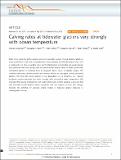Files in this item
Calving rates at tidewater glaciers vary strongly with ocean temperature
Item metadata
| dc.contributor.author | Luckman, A. | |
| dc.contributor.author | Benn, Doug I | |
| dc.contributor.author | Cottier, F. | |
| dc.contributor.author | Bevan, S. | |
| dc.contributor.author | Nilsen, F. | |
| dc.contributor.author | Inall, M. | |
| dc.date.accessioned | 2015-11-05T15:10:04Z | |
| dc.date.available | 2015-11-05T15:10:04Z | |
| dc.date.issued | 2015-10-09 | |
| dc.identifier | 228702228 | |
| dc.identifier | bd8cf7f6-0466-46b1-b141-cbd989ec1098 | |
| dc.identifier | 84944112102 | |
| dc.identifier | 000364932600013 | |
| dc.identifier.citation | Luckman , A , Benn , D I , Cottier , F , Bevan , S , Nilsen , F & Inall , M 2015 , ' Calving rates at tidewater glaciers vary strongly with ocean temperature ' , Nature Communications , vol. 6 , 8566 . https://doi.org/10.1038/ncomms9566 | en |
| dc.identifier.issn | 2041-1723 | |
| dc.identifier.other | ORCID: /0000-0002-3604-0886/work/64697366 | |
| dc.identifier.uri | https://hdl.handle.net/10023/7747 | |
| dc.description | TerraSAR-X data were provided by DLR (project OCE1503), and funded by the Conoco Phillips-Lundin Northern Area Program through the CRIOS project (Calving Rates and Impact on Sea level). A.L. and S.B. are affiliated to the Climate Change Consortium of Wales (C3W). Mooring work is supported by the UK Natural Environment Research Council (Oceans 2025 and Northern Sea Program) and the Research Council of Norway (projects Cleopatra: 178766, Cleopatra II: 216537, and Circa: 214271/F20). Contribution by F.C. was undertaken through the Scottish Alliance for Geoscience Environment and Society (SAGES). | en |
| dc.description.abstract | Rates of ice mass loss at the calving margins of tidewater glaciers (frontal ablation rates) are a key uncertainty in sea level rise projections. Measurements are difficult because mass lost is replaced by ice flow at variable rates, and frontal ablation incorporates sub-aerial calving, and submarine melt and calving. Here we derive frontal ablation rates for three dynamically contrasting glaciers in Svalbard from an unusually dense series of satellite images. We combine ocean data, ice-front position and terminus velocity to investigate controls on frontal ablation. We find that frontal ablation is not dependent on ice dynamics, nor reduced by glacier surface freeze-up, but varies strongly with sub-surface water temperature. We conclude that calving proceeds by melt undercutting and ice-front collapse, a process that may dominate frontal ablation where submarine melt can outpace ice flow. Our findings illustrate the potential for deriving simple models of tidewater glacier response to oceanographic forcing. | |
| dc.format.extent | 7 | |
| dc.format.extent | 4411862 | |
| dc.language.iso | eng | |
| dc.relation.ispartof | Nature Communications | en |
| dc.subject | GC Oceanography | en |
| dc.subject | GE Environmental Sciences | en |
| dc.subject | 3rd-NDAS | en |
| dc.subject | BDC | en |
| dc.subject | R2C | en |
| dc.subject.lcc | GC | en |
| dc.subject.lcc | GE | en |
| dc.title | Calving rates at tidewater glaciers vary strongly with ocean temperature | en |
| dc.type | Journal article | en |
| dc.contributor.institution | University of St Andrews. Bell-Edwards Geographic Data Institute | en |
| dc.contributor.institution | University of St Andrews. School of Geography & Sustainable Development | en |
| dc.contributor.institution | University of St Andrews. Geography & Sustainable Development | en |
| dc.identifier.doi | https://doi.org/10.1038/ncomms9566 | |
| dc.description.status | Peer reviewed | en |
This item appears in the following Collection(s)
Items in the St Andrews Research Repository are protected by copyright, with all rights reserved, unless otherwise indicated.

